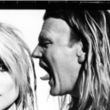'I’m Dutch; I was born in 1945. I’m the oldest of twelve kids. My father was a barber, Catholic. I became a barber because I had to help the family, and everybody had to chip in. I was the oldest, and as soon as I was big enough—twelve years old—I started working in the barbershop, sweeping, and this and that. Only men’s hair—it was a real village, full of farmers. My first actual act beyond washing the floor was soaping up these guys two times a week—I would soap them up and my father would shave them. And then to learn how to cut, it was perfect; it’s exactly what happened later: he would draw me a line, and I would go up there with the shaver and get rid of everything under the line, and then he would come back and make the transition a little sweeter. But this is remarkable because in the end, thirty years later when I did this radical haircut on Bonnie Berman, all of that came back somehow…the only difference was I didn’t make the gradient that my father always made. I simply drew a line, left it. So that was that. They call it the undercut now.
When I did it on Bonnie Berman in Milan on a Vogue job, Polly Mellen was in the other room, the machine made an awful noise because it was an American machine stuck into European current and the thing was just aaaarrrrr, but we did it. Polly walked in, freaked out, left. We didn’t see her for the day. I don’t think she had a clue: to be mad, to be happy, to be anything. It was just too bizarre for everybody. Arthur Elgort, Bonnie and I were in complete cahoots. It was perfect, and the thing was, we could just let the hair down and you wouldn’t see anything. So Polly calmed down, and we did the rest of the job the next day with the hair down, the undercut not to be seen. Vogue actually for years afterwards was not into that whole thing anyway. But then the next day we flew to Paris and did a style around this haircut for a Comme des Garçons show, Spring ’84, and that made a big to-do. I went to my room in the Crillon after the show, and there was a line of kids waiting for me downstairs, going, ‘Can I have it? Can I have it?’ I did it always. On anybody. It was much later that all the models had some form of the bottom taken away and all that. For me, it was about function because I was sick and tired of—I had done a thousand fashion shows by then—and I was sick and tired of the chignon that would always sag out at the base of the head. I wanted it to be clean there, have no hair there. But it came about, ‘What are we going to call this?’ And Bonnie said, ‘It sounded like a buzz, so let’s call it a buzz.’ And it was ‘buzz’ for many years. But then it disappeared, I suppose. Vogue paid no attention. I did it with guys too, for GQ, and they didn’t want to publish it, they said it was not ‘family.’ But immediately French Marie Claire got a hold of it, and they played it big, so it got on the map.
Anyway, before all that, my father felt I should also learn the woman thing, so he sent me to the women's beauty school in Amsterdam for a year. I got all that down, and basically, I was meant to take over the barbershop and maybe expand it to the women in the village, as well. But military service called, and in those years you had to spend two years of your early life in the military service. It’s not a volunteer thing, you got drafted, the first sons of every family. So I was nineteen or eighteen, I got drafted, and I picked the Marines, because the Marines, I noticed, they go out of the country. [Laughs] And that was kind of crucial, because I did become a Marine, and they did sent me to Aruba and Curaçao and the Dutch islands. A woman took a liking to me and took me under her wing to do her hair. When my time was up, the woman said, ‘You’re good, you should go to America.’ She writes a letter to the editor-in-chief of Glamour, who she thought she had gone to school with. The editor is Amy Greene. I still don’t know if the woman actually went to school with Amy Greene or if she just saw the picture and thought she went to school with Amy Greene, but it turned out her name was exactly the same as the most famous Broadway actress in New York in those days: Lotte Lenya, the wife of Kurt Weill, the composer of Cabaret, Threepenny Opera, all those kind of shows. So Amy Greene thinks it’s the Mrs. Kurt Weill, Lotte Lenya, on vacation in Aruba, sending her the letter. So they send her a letter back, saying, ‘When he comes, absolutely, let us know, blah blah blah.’ I arrive, and there’s a limousine waiting for me—and I’m twenty-one! I’ve never been to America. And I’m not Christaan yet, I’m just Pete, Peter, originally.
Glamour had set up a schedule for a week in New York, so I came here on my way back home. I stopped in Miami to buy a suit—I got a suit with two buttons; it was the 60s, tight—and they sent a car in the morning to pick me up. I had a schedule, it was five days, and each day they would drop me off at one of the five fancy salons in New York: Kenneth, Michel Kazan, Vidal Sassoon…they would drop me off, introduce me to the guy, and for the day I could stand around watching these stars fool around. And each of them were equally kind to me. I couldn’t even speak English well; I just shut up and looked. At the end of one day when Vidal Sassoon left, he took his tie-clip off—it had a little scissor on it—and he gave it to me for good luck. We became good friends afterwards, so there was that. I go back to Holland, and immediately letters arrive [asking] if I want to go back and work for one of those companies. It was Kenneth’s and Bergdorf Goodman. I’d seen the Bergdorf Goodman beauty salon: fancy old pink rooms with blue chandeliers. Coiffures Americana, it was called. And meanwhile I thought, ‘It’s going to take a while, a couple of months, so I better learn the language before I go.’ So I went to hitchhike to Geneva—I was afraid of Paris, but I wanted to learn French. I thought, ‘If you are a coiffeur, you certainly need to speak French.’ Then I could choose between LA or New York, I said, ‘Okay, New York.’
The salon at Bergdorf Goodman was constituted by grand old coiffeurs, a bunch of gay guys, at least forty, fifty years old. So I think nothing else more than I’m going to be a shampoo boy. I get here, and they put me in a chair in the corner, and I do that for a couple of weeks. They were testing me to see if I was what they had in mind. They were setting up every beauty and fashion editor to come in for a free gig, so I met everybody in the first two weeks. I came from the Marines, I didn’t have a clue about anything; I just shut up, and did what I did. But I had a passionate hair situation. It was the time when Sassoon was taking hair down…I was as good as that, and as confident in the future of hair as much as any of these characters. And I applied very well without saying a word, because I wasn’t speaking English whatsoever. But I was cute, and cute was a big thing. [Laughs] I was twenty-one, twenty-two, Dutch. And within a few months they made me creative director of Bergdorf Goodman, which basically meant I was paid to go with models and actresses to their job, which didn’t happen before. Before, they would come, get done, and they would go. There were basically five guys who were set up to go with models to shoots; I didn’t know anybody, I was alone in the beauty salon. So in a half a year, I was standing in the ballroom of the Waldorf Astoria for this, or Johnny Carson that—I had no idea who Johnny Carson was. I just did it. I figured it out. So that’s how I basically got established. And in the meantime, I flew back to Holland and married a girl I’d fallen in love with in Amsterdam—Marianne.
In ‘68, we lived a typical life of hot-shots in New York. We ended up being well-connected because of my work. China Machado, Paloma Picasso, Elsa Peretti, Karl Lagerfeld, Bianca Jagger... We ended up in that little group somehow. It’s not what I do now anymore, but it was wild and crazy. There was this completely exuberant, free, bundle of kids that lived to the hilt. We weren’t bosom buddies, but we were in there. At the same time, we were just a young couple trying to establish ourselves and make a life for ourselves in New York. The situation at Bergdorf Goodman changed very quickly because I had gotten fed up with the chandelier shit and the grandmas. The daughters of these fancy women would also come in, and I said, ‘We can’t treat them the same way—it’s a different thing.’ So I talked them into setting up a separate salon, which I did on the sixth floor, called BG Cut Away. It was a big hit; this was around ‘69. But I wasn’t pleased with the company, and I started making trouble. I didn’t wear the right color suits, because I had gone to Paris and bought brown Pierre Cardin suits with zippers and the policy was to wear blue suits, and I refused. Boom, I was out. And I was on the street. But those young editors, like Mary Carter and Sandy Brant, all these girls, when they started working at Mademoiselle, Glamour, Vogue, they kept calling me, and so all of a sudden I was freelance. And Marianne ended up working at Harper’s Bazaar as a junior fashion editor.
I met Arthur [Elgort] real early, in the end of the sixties—‘69. Mary Carter was the editor of Mademoiselle—she was one of the girls I had met in those first two weeks that I kept my eye on. But anyway, she booked me for a cover try with Arthur and some French actress. The absolutely flabbergasting thing about it was that he shot the cover in a phonebooth on the corner of Second Avenue and Eighty-something street. Until then I had only met Avedon, Hiro—I worked with Hiro at Bazaar—hotshots. And here’s this kid, that just takes the girl, puts her in a phone booth, and comes up with the cover. That was just perfect for me. That completely clicked with my sense of hair, and sense of future, how things should be done. I was into getting a woman to live with their hair freely, and to not support hair on the person that isn’t really their hair. I would not take whatever style and say, ‘This is for you.’ I would look for what you got, and try to make that as positive as I could; fit it to the person. I’m the one who came up with the idea that curly hair belongs to curly people, straight hair belongs to straight people. Don’t make straight hair belong to people with curly hair. That was my shtick. And I had the techniques, and the know-how, the charm probably. I was passionate; I was dictatorial. But it was the right thing at the time, so it stuck. I was with Arthur pretty much the whole seventies, eighties, early-nineties. I worked with all the other people, too, a little bit, but we were the first team. Later there were other teams…Garren and Meisel; Meisel was a groupie when I started, following me to try to get into fashion shows and stuff—it was cute.
Aside from that, there were the fashion shows. I got the job at Calvin in ‘69 or ‘70. The Seventies, we all went to Fire Island and became friends, and I did everything for him—shows, appearances, you name it. Giorgio, Bill Blass, I did everyone, basically. I did Donna Karan for a good ten years, and then at the same time in Paris, I did Comme des Garçons. You have to be very on your toes for Comme des Garçons. Wild and crazy was more Calvin—it wasn’t wild and crazy, but it was natural. I could say, ‘ She looks good, don’t touch her.’ All these characters were into keeping women women. Calvin was the first one to take the magazine girls—the models shown in photographs—and have them walk the runway. It used to be a distinct set of runway girls, and a distinct set of girls in the magazines. Completely different. They never crossed. And so I had to come up with a new shtick...you just wanted to make the girls look great, and feel great—that was truly the seventies. Vogue also was totally into the woman: ‘We need to get the woman out.’ That doesn’t exist anymore, but that’s the way they wrote, and it certainly was perfectly of my element.
At the same time in Europe, Comme des Garçons was a whole other shtick—I couldn’t bring that there. What I brought there, why Rei hired me, was she saw that I had a certain lightness of touch. I know my first thing was maybe ‘81. When she came to New York, she asked to see me, and she had a couple of these fabric hats that she wanted to have in the show, but she needed somebody to be able to put them on in just the right way. And I fit that bill because I can do that; I have a sense about that kind of stuff. It had to have a certain sameness, but still a certain spontaneous variation through the sameness. Somehow I could do that. I was the last person every model saw before they went out: there was the dresser, there was the designer, and then there was me, all those years. You can’t delegate it, I did it myself. But Rei, every season, would have a very distinct desire—point of view—whereas people like Calvin and Giorgio, the general sense of their creativity would be in the realm of, ‘Make the girls look beautiful,’ or in Bill Blass’ case, to make the babes that sit in the audience be all, ‘Wow, I want to be like that woman.’ I had a very small team of friends, nothing about assistants or anything, we’d just do it— we’d race through thirty or forty girls. But with Rei, you really had to force yourself to figure a point of view, which had nothing to do with it being a natural woman or anything. She would just grab on to one word that I would write: ‘jagged.’ I would send twenty drawings, and she would come back with, ‘Okay, it’s ‘jagged.'’’ And then I would have to go there. It’s sharper and stricter. From season to season, from show to show, one had absolutely nothing to do with the other.
The Céline show [Spring 2011] was a fluke; Phoebe [Philo] and Camilla [Nickerson] convinced me, ‘You can do it!’ I gave up shows in the beginning of the nineties when everything went corporate and you needed twenty assistants. I had no idea about that; I did everything by myself with a bunch of friends. The new thing I wasn’t set up for—I didn’t know how to get twenty people together and tell them what to do, to just stand there and watch them. I’m like a singer or a writer or a painter: it’s me, it’s not them. That’s just how I always was, and I like it. I was asked [to do hair] for that particular reason, and am still being asked forty years later. So I’m not going to force myself into that other thing; I’m not looking to expand my business or anything. I love my life, I love my spot, I’m perfectly happy to keep that.
Everything is completely different now, that’s one given. It’s hard to put in words exactly how things change because it gets very cliché. I have several angles that I can point to: first of all, out of the fifties and sixties, came the seventies and eighties, when I became aware of fashion and played a role in it. That was counter to, or came out of, the era where at least in hair—and to a similar degree, fashion—it had to be liberated. It was liberating: freedom, real hair. Get women out of the ‘set,’ where they would come to the salon—which is what I saw when I arrived in New York—to get their hair done. They had to be careful going to bed. I always thought, ‘What do you do when you get laid?’ [Laughs] The entire industry was about empowering women, and at the end of the eighties, an entire new crew—Meisel, Oribe, Carine—they wanted not to do that. They wanted to create characters, so it became much more a character-driven job. You had to decide, ‘Who is this woman?’ You couldn’t care less who she actually is, but who can we turn her into? Is she a hypochondriac, or is she a slut? You name it. I laugh when I hear all those things, those references. Besides the woman who is in there, it’s about creating interesting images, which is totally valid. I struggled with it, I must admit, but I got it, and I know how to do it with my hands. It’s a very enjoyable game. I must say, my heart is not into it as much as it was earlier—when [fashion] went for women—but I do realize that it is not entirely gone. Arthur became Arthur—and Marianne became his agent—because he can put any girl against any wall and take a gorgeous picture of her. Because of this, the sense of insight, connection, you can go through pictures and say, ‘That’s his.’ It doesn’t matter if there’s a clown in the background or bubbles or whatever art directors come up with. And I see that quality in working with Mario [Sorrenti], David Sims... I recognize that they do still have that, they just have to pump it up.
You can’t have a magazine anymore unless it’s spectacular. The other day I did a photoshoot with Kate [Moss], and I said, ‘Please let Kate be Kate. Treat her as a woman.’ That doesn’t mean you can’t do anything [to her hair or makeup]; it’s almost as difficult and nerve-wracking as doing something fabulous. If you look at Vogue and see these crazy hairdos, a lot of them are static—you make it on the head, you stick it on there, done. But because I did it, it goes left and right. It’s not always going to look great—that was the old style. It’s about how the light falls on it, where you’re standing, the angle. It’s life, it’s flowers opening. 'Great' is totally subjective. And that still is inspiring to these people, but like with Kate the other day, it’s very delicate…it’s like splitting hairs, literally. And just one finger can make the difference between something gorgeous that the photographer says, ‘This is it, yes!’ but two frames later, it’s garbage. And so I’m walking on hot coals, even though people would look at it and go, ‘It’s just Kate!’ You have to constantly be in there. The girls will always look at me from set, and I’ll have an expression that relates to them. When I come to them, they know it’s okay. I love that! That’s spectacular! Then I feel like a painter, even though I barely do anything.
I’ve had fantastic, lucky, coincidental challenges that have shaped my realm of being able to deal with God-knows-what. You can be a great technician, but it’s like a painter: you take ten painters, ten young kids, they have to paint the same thing. One of them has a reason, they stick out. It comes from their personality, their insides coming out. What it is about my personality, I’m definitely a thinker, less social than you think, even though I’m known to be quite a social animal at times. For me, my thinking, my analyzing of everything joined together with my Dutch laissez-faire background, and the opposite of being stuck up, must have something to do with it. It’s probably the core of it; I can see virtue in anything. If you tell me one thing, it’s supposed to be like that, and if you told me five seconds later it’s the other thing, it’s fine, it’s okay. I can go left and right easily.”
—as told to ITG
Photographed by Emily Weiss in New York on August 2nd 2012 [1-6]; Christiaan's selection of work and snapshots [7-11].






















